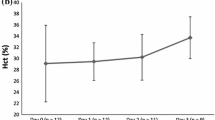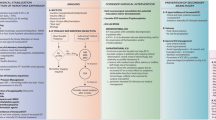Abstract
Background
The prevalent use of anticoagulation in a growing elderly population has led to an increasing incidence of intracerebral hemorrhage. Furthermore, the understanding of the interactions and adverse effects of oral anticoagulants when used with non-FDA approved drugs is limited. Diosmin is one such non-FDA approved drug which is a semisynthetic, phlebotropic supplement with multiple microcirculatory effects. We report a case of a patient on oral anticoagulation and diosmin, who presented with spontaneous intraventricular hemorrhage, and discuss the possible etiology behind this rare event.
Methods
A retrospective chart review and a comprehensive search of the literature using the PubMed database were performed.
Results
A 77-year old female with a 6 week history of warfarin therapy and a several year history of diosmin use presented with severe bitemporal headache. Computed tomography scan revealed an acute hemorrhage within the right ventricle without associated intraparenchymal hemorrhage. International normalized ratio measured 1.8 and was corrected using fresh frozen plasma and vitamin K. She was discharged without neurological deficits.
Conclusions
Diosmin inhibits platelet aggregation and prolongs the effect of norepinephrine on venous tone, leading to increased venoconstriction. The combined effect of chronic microcirculatory hypertension and inhibition of platelet aggregation due to diosmin may have predisposed to spontaneous hemorrhage in this anticoagulated patient. Individual cases such as this serve as a reminder that over-the-counter dietary supplements may be associated with serious adverse events. The practicing clinician should be aware of this possible adverse event when evaluating patients on oral anticoagulation and chronic diosmin treatment.

Similar content being viewed by others
References
Cospite M. Double-blind, placebo-controlled evaluation of clinical activity and safety of Daflon 500 mg in the treatment of acute hemorrhoids. Angiology. 1994;45(6 Pt 2):566–73.
Flaherty ML, Kissela B, Woo D, Kleindorfer D, Alwell K, Sekar P, et al. The increasing incidence of anticoagulated-associated intracerebral hemorrhage. Neurology. 2007;68(2):116–21.
Gryglewski RJ, Korbut R, Robak J, Swies J. On the mechanism of antithrombotic action of flavonoids. Biochem Pharmacol. 1987;36(3):317–22.
Katsenis K. Micronized purified flavonoid fraction (MPFF): a review of its pharmacological effects, therapeutic efficacy and benefits in the management of chronic venous insufficiency. Curr Vasc Pharmacol. 2005;3(1):1–9.
Maksimovic ZV, Maksimovic M, Jadranin D, Kuzmanovic I, Andonovic O. Medicamentous treatment of chronic venous insufficiency using semisynthetic diosmin—a prospective study. Acta Chir Iugosl. 2008;55(4):53–9.
Naff NJ. Intraventricular Hemorrhage in Adults. Curr Treat Options Neurol. 1999;1(3):173–8.
Palmer GC. Neurochemical coupled actions of transmitters in the microvasculature of the brain. Neurosci Biobehav Rev. 1986;10(2):79–101.
Struckmann JR, Nicolaides AN. Flavonoids. A review of the pharmacology and therapeutic efficacy of Daflon 500 mg in patients with chronic venous insufficiency and related disorders. Angiology. 1994;45(6):419–28.
Swies J, Robak J, Dabrowski L, Duniec Z, Michalska Z, Gryglewski RJ. Antiaggregatory effects of flavonoids in vivo and their influence on lipoxygenase and cyclooxygenase in vitro. Pol J Pharmacol Pharm. 1984;36(5):455–63.
Taheri SA, Wani MA, Lewko J. Uncommon causes of intraventricular hemorrhage. Clin Neurol Neurosurg. 1990;92(3):195–202.
Zubkov A, Claassen DO, Rabinstein AA. Warfarin-associated Intraventricular hemorrhage. Neurol Res. 2007;29(7):661–3.
Van Der Meer FJ, Rosendaal FR, Vandenbroucke JP, Briët E. Bleeding complications in oral anticoagulant therapy. An analysis of risk factors. Arch Intern Med. 1993;153(13):1557–62.
Hart RG, Benavente O, Pearce LA. Increased risk of intracranial hemorrhage when aspirin is combined with warfarin: a meta-analysis and hypothesis. Cerebrovasc Dis. 1999;9(4):215–7.
Conflict of interest
None.
Author information
Authors and Affiliations
Corresponding author
Rights and permissions
About this article
Cite this article
Kumar, R.M., Van Gompel, J.J., Bower, R. et al. Spontaneous Intraventricular Hemorrhage Associated with Prolonged Diosmin Therapy. Neurocrit Care 14, 438–440 (2011). https://doi.org/10.1007/s12028-011-9524-9
Published:
Issue Date:
DOI: https://doi.org/10.1007/s12028-011-9524-9




